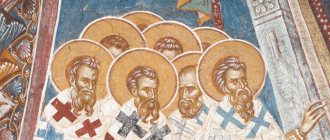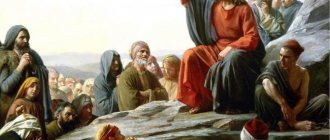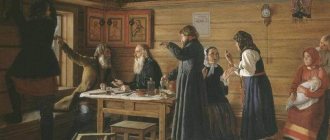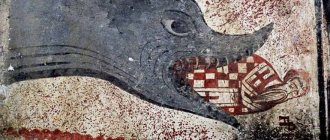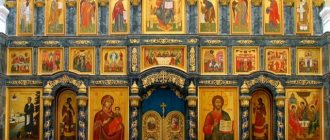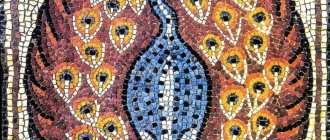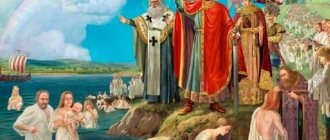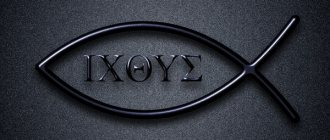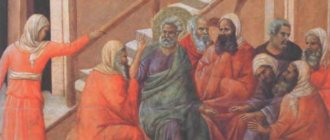In Dahl's dictionary
and. in general, difference of opinion of faith; schism or defection, apostasy. We call Old Belief, adherence to Orthodox dogmas in everything, using old-written icons, old printed books and ancient chants (this is Edinoverie, blessed church); schism, all the talk of clerical and non-priestly behavior, which has not recognized the church hierarchy since the time of Patriarch Nikon, regarding the correction of books; heresy, ugly talk, more or less rejecting the essence of Christian teaching, such as: the Doukhobors, Molokans, Khlysty, Skoptsy, Subbotniks, etc. Heresy and Oshera live in disagreement. A heresy leader, a heresiarch who founded a heresy or is revered by his followers as an elder. Heresy-initial, related to him, or related to the beginning of the heresy. Heresy teacher, heresy teacher, m. spreading heresy. A heresy champion is one who advocates heresy. Heretic or heretic m. heretic, heretic or heretic f. apostate, schismatic, renegade, convert to heresy. | Heretic or heretic Sever. eastern abusive, sorcerer, wicked, harmful healer, spoiling people, sending damage. | Psk. every reptile, snake, frog. Fear the slanderer as an evil heretic. Heresy, heresy. Heretical, heretical, related to heresy and heretics. Heresy cf. heresy in action, in application, apostasy, renegade. To be heretical, to be a heretic, or to deviate in some way from the fundamental tenets of faith.
Meaning of the word heresy
'heresy ( Greek)
separation) (Acts 5:17; Acts 15:5; Acts 24:5,14; 2 Peter 2:1; Gal. 5:20) is a false teaching that is presented as true. Heresy is not an extraneous teaching, it is always an internal enemy. The Sadducees, whose teachings basically coincided with the teachings of the Pharisees, but differed only in their non-recognition of the resurrection and Angels, were heretics for them (Acts 5:17; Acts 23:8), although both teachings were within the framework of the Law of Moses. Ap. The Pharisees called Paul a representative of the Nazarene heresy (Acts 24:5), because they did not recognize Jesus of Nazareth as the Messiah, fearing undermining the foundations of their own teaching. But the very teaching of the Pharisees in Acts 15:5 is called heresy (in relation to Christianity), since some of the believing Pharisees began to insist on the fulfillment of the Mosaic Law also by other pagan believers. The teachings of Nicolaitans, Balaam and Jezebel mentioned in Revelation (Rev. 2:6,14,15,20), which were held by some believers in the Pergamum and Thyatira churches, can obviously also be called heresies.
There are a number of heresies known in the history of the church. Moreover, in the first centuries of Christianity they had the character of a distortion of the true teaching, and later (with the strengthening of the papacy and the statehood of Christianity) - a Protestant, liberating character and, thus, were a “heresy” only for the papacy.
Gnostics
(from
the Greek
gnosis - knowledge) (1-3
centuries
) - followers of the doctrine according to which the world and matter are evil, and therefore God cannot even touch them. According to this teaching, the world was created by intermediate deities (emanations), one of which is Christ. Since the flesh is evil, it must be completely ignored and suppressed, or, conversely, completely satisfied without attaching any importance to it. Their teaching about salvation is not clear, for all the texts of Gnostic authors were destroyed by the church authorities and only quotations in theological works were preserved, from which it can be concluded that, according to their ideas, the world, gradually purified, can be reconciled and reunited with the deity. Similar ideas are still alive today, especially among senior church leaders who preach universal reconciliation.
Manichaeans
(3rd
century
) - followers of Mani (214-277
)
, the basis of whose teaching is the incessant struggle of the originally existing evil (darkness) with the also originally existing good and truth (light).
Reasonable souls are captivated by an evil but unreasonable world. Christ came to take His own, giving them knowledge of themselves. They are saved through the complete denial of the external and the awareness of their chosenness, their highest nature. In the days of his youth, before his conversion, Augustine was strongly captured by this teaching, although he saw many of its shortcomings. Mani was persecuted for abandoning his own religion (Zoroastrianism, which was generally similar to his teachings), fled to India, then returned to Persia, was captured and executed. His teachings spread throughout the Roman Empire, but soon began to be persecuted everywhere. The last ban was proclaimed in China in the 14th century.
It served as an impetus for the emergence of the teachings of the Paulicians, Cathars, and Albigensians.
Ariana
(4th
century
) - followers of the Alexandrian priest Arius, who denied the consubstantiality of God the Father and the Son and considered Christ to be something in between God and man.
Convened by Emperor Constantine in 325
The first ecumenical council in Nicaea condemned Arianism as a heresy, but later Constantine supported Arius for some political reasons and gave him official patronage.
At the Second Ecumenical Council in 381 .
in Constantinople, Arianism was again condemned.
Donatists
(4th
century
) - followers of Donatus, whose movement arose as a result of the refusal of the local community in Carthage in 311
.
recognize Bishop Caecilian, newly appointed from Rome.
The Donatists formed their own community, which called on believers to live a simple life, to refuse cooperation with the state and from the baptism of children, which had already become a practice. At the meeting convened in 411
At a special local council in Carthage, the teaching of the Donatists was called heresy, prohibited, and its followers were subjected to severe persecution.
Nestorians
(5th
century
) - followers of the Patriarch of Constantinople Nestorius, who organized widespread persecution of the Arians.
In his teaching, he denied the supernatural birth of Christ and insisted that from Mary (he called her the Mother of Christ) a simple man was born, in whom the Holy Spirit then settled and dwelt in him as in a temple. At the Third Ecumenical Council in Ephesus in 431 .
This teaching was condemned, and Nestorius was exiled.
His supporters fled to Iran, Central Asia, and China. In 499
they managed to gather their own council in Seleucia and organize their own church with its own hierarchy.
Monophysites
(5th
century
) - followers of Archimandrite Eutyches, who taught (as a reaction to Nestorianism) that in Christ one essence predominates - the Divine, and the human is completely absorbed by it.
This teaching became widespread and the bishops of cities such as Alexandria, Antioch and Jerusalem became its adherents. At the Council of Ephesus in 449 .
(to which, however, the majority of bishops were not invited), the Monophysites proclaimed their teaching “official.”
Fourth Ecumenical Council in Chalcedon in 451
called this council “robber” and canceled all its decisions.
However, at the next - the Fifth Ecumenical Council in Constantinople in 553 .
concessions were made to the Monophysites on some issues. In the 6th and 7th centuries they were the cause of many unrest.
Monophelites
(6-7
centuries
) - followers of the next teaching, which arose as a reaction to the previous one.
The Monothelites argued that although Christ possessed two essences - Divine and Human, He possessed only one will - Divine, which completely absorbed the human. This teaching was supported by Sergius, the Patriarch of Constantinople (610-38 )
and Emperor Heraclius, who in
638
it was officially approved.
Maximus the Confessor very sharply rejected this teaching, saying that the human will retains its independence in Christ, but is freely subordinated to the Divine. At the Sixth Ecumenical Council in Constantinople (680-81 )
, monothelitism was condemned. At this time, Islam was already raging in Asia.
Pavlikians
(7
v.
) —
poss.
, the first predecessors of the Protestants.
The origin of the name is unknown. Some believe that it comes from the name ·ap.
Pavel.
The teachings of the Paulicians spread to western Armenia, Constantinople, and Asia Minor. They rejected the baptism of children, the Catholic hierarchy, monasticism, icons, worship of the Virgin Mary and saints, and the division into clergy and laity. In the middle of the 9th century.
The Paulicians separated from Byzantium and organized their own state with its capital in Tefrik.
But already in 872
they were defeated, and in
878
lost their capital.
Empress Theodora destroyed up to 100 thousand.
Paulicians as heretics and resettled many to the Balkans, where they contributed to the emergence of Bogomilism.
Iconoclasts
(8th
century
) - representatives of the next wave of struggle against official religion.
At 730
Emperor Leo III banned the worship of icons.
Council in Hieria (near Constantinople) in 754 .
declared the veneration of icons to be heresy, but it was soon restored.
At the Seventh Ecumenical Council in Nicaea in 787 .
iconoclasm was declared heresy.
Bogomils
(10th
century
) - followers of the Paulicians in the Balkans (Macedonia, Bosnia, Serbia, Bulgaria). They condemned wealth, the worship of the cross, relics, and saints. The Byzantine Emperor Alexy 1 converted them to the Orthodox faith especially cruelly. He burned the Bogomil leader Vasily.
Cathars
(from the word pure) (11-13
centuries
) - followers of the Bogomils in Italy, Flanders, and southern France. They preached asceticism, rejected the Catholic Church with all its institutions and considered the pope to be the vicar of Satan. They were subjected to terrible persecution.
Waldenses
(12th
century
) - followers of the Lyon merchant Waldo, who gave away his wealth and preached poverty and asceticism, life without property and family (apostolic life). His followers appeared in Spain, Italy, Germany, the Czech Republic, and Switzerland. Of all the institutions of the Catholic Church, they recognized only baptism and communion. They rejected icons and the monopoly of priests on preaching, believing that anyone capable of preaching could preach. They were subjected to persecution and burning, which increasingly began to be practiced against heretics.
Albigensians
(12-13
centuries
) - followers of the Cathars and Waldenses in southern France.
They considered the earthly world and the Catholic Church to be the creation of Satan. Crusades were organized against them (the Albigensian Wars) and the Inquisition, officially created at that time (1215 )
, was sent with its tortures and bonfires.
Since the 13th century.
there were “no more heresies,” since the Inquisition was now vigilantly monitoring any dissent.
Back in 1184
under Pope Lucius III and Emperor Frederick I Barbarossa, an episcopal court was organized that searched for heretics, convicted them and handed them over to civil authorities for execution.
In 1215
The Inquisition was sanctioned (at the Fourth Council of Laterns) and its implementation was entrusted to members of the Dominican and Franciscan orders (later the Jesuits).
The Inquisition was abolished in most European countries in the 18th century.
, in Portugal - in 1820
.
, in Spain - in 1834
.
and in the papal region - in 1859
.
In Russia, Christianity was introduced in the 10th century.
and for a long time no heresies were noted.
In the 14th century
a movement of “Strigolniks” arose (the meaning of the term is unknown), spreading in Pskov, Novgorod and later even penetrating Moscow.
His supporters, like later “non-covetous” people, protested against excessive exactions in all rituals, rejected the exclusive right of priests to preach, and called for an ascetic life. But in the 15th century.
this movement gradually disappeared.
In the 16th century.
Theodosius Kosoy “erected a new teaching,” in which he called for salvation through good deeds, but was forced to flee to Poland.
In the 17th century
In connection with the reforms of Patriarch Nikon, a “schism” occurred and the Old Believers began to be brutally persecuted. Many of them were burned in wooden log houses, many burned themselves.
Luther's Reformation reached Russia only at the end of the 19th century .
.
( see
church)
In Vasmer Max's dictionary
I heresyI. and. “religious false teaching, lie”, folk. heresy, Old Russian, Old Slav. heresy αἵρεσις (Supr., etc.). From Greek αἵρεσις own. "choice"; see Vasmer, Gr.-sl. this. 60 et seq. II heresyII. m. “hot-tempered, grumpy person”, folk. also heresy. Probably identical to the previous one as a swear word. Not related to ltsh. er̃rîgs “angry”, erestîba “irritability”, lat. error "error", goth. airzeis “prodigal, erring, erring”, Old Saxon. irri “wrathful” (contrary to Osten-Sacken, IF 23, 380 et seq.; 28, 411 et seq.; Persson 637; Walde - Hofm. I, 417), because Lit. er̃rîgs is a late borrowing. from Middle-Nizhny Novgorod erre, errich - the same; see M. - E. I, 571. This word is compared - also without any particular reason - with ruff.
What is Heresy? - This is a deliberate deviation from religious teachings
Nowadays, the word “heresy” carries a negative connotation, but this was not always the case. During periods of greater religious tolerance, when people could afford their own view of this or that tradition, the word “heresy” was understood by its direct meaning - “current”, “choice”, “alternative”.
Let's say there is a certain Holy Scripture and several interpretations of it. No interpreter has a monopoly on opinion and the right to call only himself an authority. Accordingly, we get two currents, two heresies. From this position, we could call Catholicism, Protestantism and Orthodoxy the three heresies of the Christian tradition.
If we call someone heretics, they can call us the same
Although it is preferable to use the word “heresy” not to all directions, but to those that exist outside of the main, orthodox tradition. But at the same time, any other philosophical school, considering itself the truth itself, has the right to call the orthodox movement a heresy. There is nothing offensive here, it is a neutral word.
- Heretics are adherents of heresy.
- Heresiarchs are the heads of the heretical movement.
The first Christians are heretics, from the point of view of Judaism (“The Last Supper”, Da Vinci)
The most famous heresiarch is Arius
The name Aria is primarily associated with the word heresy “in Christianity.” Ironically, we know little about him and his teachings, although his name is well known. Presumably this man was born in Libya. It is known that he had church ranks several times, but chose paths that were displeasing to the higher clergy.
Nevertheless, he managed to return again and again to new posts and preach. Arius showed himself to be a fairly skillful preacher, so he acquired many followers.
Arius - the most famous heresiarch
One of the main stumbling blocks between the traditional church and Arianism was the idea of the Trinity of God. Actually, in the 3rd–4th centuries, when Arius lived, this was one of the most pressing topics.
The Christological question—that’s what they called it. Theologians tried to formulate what the role of Christ is in the world, whether He was created, what kind of relationship He has with God the Creator, who is more important, whether They are one and the same, etc.
His own quote, which has survived to this day, will tell us a little about Arius’s ideas:
“For we say that the Son is neither the Unbegotten, nor a part of the Unbegotten (in any case), nor taken from the Person of a pre-existent, but that He began to be before time and ages, according to the will and purpose of the Father, as God perfect, as The One, the Immutable; that He did not exist before He was begotten, or created, or founded, for He was not the Unbegotten—this is why we are persecuted.”
As a result, it took major church debates to recognize the views of Arius as a heresy, and himself as a heresiarch. But this is not an easy task. The problem for the churchmen was that there was no information in the Holy Scriptures that would refute the views of Arius. He enjoyed the support of the authorities, was a dexterous and far-sighted man.
But still, his teaching did not stand the test of time. And there were not so many sincere supporters who were ready to give their lives for Arianism.
There is a legend that at the Ecumenical Council, Arius was slapped in the face by Nicholas the Wonderworker. It is in no way confirmed by historical events. Saint Nicholas was unlikely to be present at this meeting. However, this event is reflected in the akathist, and many preachers refer to it as a real fact.
Fourth Lateran Council
The apotheosis of the power of the church was the main event of 1215 - the Fourth Lateran Council. The canons and resolutions of this assembly determined the entire future path of development of the religious life of Western Europe. The council was attended by about 500 bishops and approximately 700 abbots - it was the most representative Catholic church event in a long time. Delegates from the Patriarch of Constantinople also arrived here.
Fourth Lateran Council. (Wikimedia Commons)
During the entire work of the cathedral, about 70 canons and decrees were adopted. Many of them concerned intra-church life, but some also regulated the daily life of the laity. The cycle of life from birth to burial - each of its elements was subjected to strict analysis and the development of church norms. It was at this council that the provisions on the church court were adopted. Thus was born the Inquisition. This tool for the church’s fight against dissent will become the most effective. Historians believe that 1215 is the date of complete Christianization of Western European civilization.
The private opinion of theologians is not heresy
There is such a concept - theologumene. This is an opinion expressed by one of the theologians. It is easy to confuse it with heresy, since personal opinion:
- Not confirmed by Holy Scripture or Tradition.
- Not mandatory for Christians.
But private opinion has a couple of distinctive features:
- Does not contradict Holy Scripture and Tradition.
- Not presented as truth.
The essence of this phenomenon is as follows. There is a certain author, a respected theologian. He discusses important issues of doctrine and comes to a point about which there are no Christian dogmas. For example, he comes to the conclusion that there must be a tenth rank of angels and the Archangel Michael belongs to it.
The theologian must admit, in order not to become a heretic, that he can be wrong
Holy Scripture and tradition say nothing on this matter, so it is impossible to confirm or refute the theologian’s opinion. This distinguishes it from heresy, since heresy comes into direct conflict with dogmas and violates them.
But for a theological opinion to become such, it is necessary
- so that the author of this statement himself admits that his version is private and cannot be generally accepted.
- so that the statement fits into information from Holy Scripture and Holy Tradition.
By leaving a comment, you accept the user agreement
In Orthodoxy, heresy must be fought only with arguments and kindness
Orthodoxy, in its true nature, condemns attempts to denigrate other teachings and try to destroy heretical organizations. Archpriest Oleg (Stenyaev) speaks about it this way:
Oleg (Stenyaev)
Archpriest
“You cannot fight sectarians using non-Christian methods, as some missionaries do. Such missionaries put aside the Bible and pick up the Civil or Criminal Code. They are only engaged in collecting incriminating evidence on sect leaders and ordinary sectarians. What can you say about this? Their research, from a religious point of view, is obviously useless, their activities play into the hands of the opponents of Orthodoxy.”
But it is especially useful for an Orthodox person to read what Archbishop John (Shakhovskoy) says:
John (Shakhovskoy)
Archbishop
“It is a mistake to think that all Orthodox are really not sectarians and that all sectarians are really not Orthodox. Not every Orthodox by name is like that in spirit, and not every sectarian by name is like that in spirit, and nowadays in particular one can meet an “Orthodox” - a real sectarian in spirit: fanatical, unloving, rationally narrow, resting on the human point, not hungry, not thirsty for the truth of God, but satiated with his proud truth, strictly judging a person from the top of this imaginary truth of his, outwardly dogmatically right, but devoid of birth in the Spirit.
And vice versa, one can meet a sectarian who clearly does not understand the meaning of Orthodox service to God in Spirit and Truth, who does not recognize this or that expression of church truth, but in fact conceals within himself a lot of what is truly Godly, truly loving in Christ, truly brotherly towards people... Then how among Christians of other faiths there are many who live in the truth of Orthodoxy - in their spirit.
There are sectarians who burn in spirit and with love for God and for their neighbors much more than other Orthodox Christians, and this spirit of burning love for God and for man is a sign of true, vital Orthodoxy. Whoever does not have it among the Orthodox is not truly Orthodox, and whoever has it among the non-Orthodox is truly Orthodox.
Humanly he is mistaken, humanly he does not understand this or that, does not see this or that color in the nature of the world (spiritual color blindness; does not see, for example, the meaning of icons, communication with saints who have departed from this world); but in spirit, in his inner man, he is faithful and true, devoted with unfeigned love to the Living God, the Incarnate Lord Jesus Christ, unto death.”
Orthodoxy is the path of kindness, understanding and care for one's neighbor. Therefore, it is permissible to try to reason with the heretic, but if this did not work out in the first couple of conversations, you should leave the person alone:
(Titus 3:10)
“Heretic, after the first and second admonition, turn away”
Chapter 3 of Titus: Heretics, after the first and second admonitions, turn away
